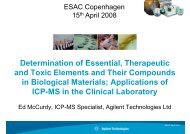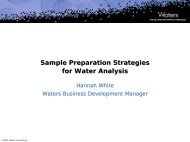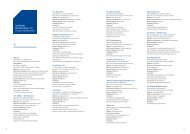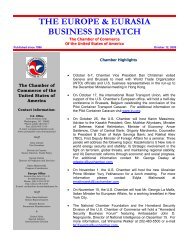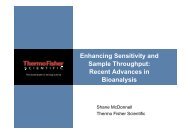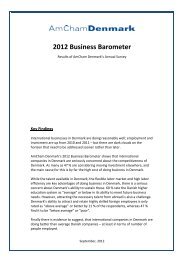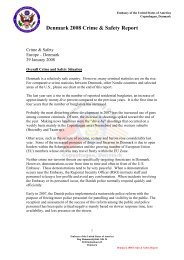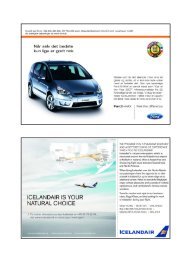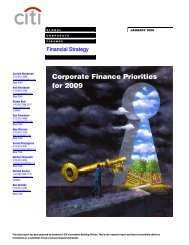Create successful ePaper yourself
Turn your PDF publications into a flip-book with our unique Google optimized e-Paper software.
<strong>Biodiesel</strong> <strong>–</strong> <strong>What</strong>, <strong>Why</strong> <strong>and</strong> <strong>How</strong><br />
Helge Madsen<br />
PerkinElmer LAS
Page 2<br />
<strong>What</strong> is <strong>Biodiesel</strong>??<br />
<strong>Biodiesel</strong> is a clean burning alternative fuel, produced from<br />
domestic, renewable resources. (vegetable oils (new <strong>and</strong> used),<br />
sewage, animal fats, algae…)<br />
<strong>Biodiesel</strong> contains no petroleum, but it can be blended at any<br />
level with petroleum diesel to create a biodiesel blend.<br />
<strong>Biodiesel</strong> is simple to use, biodegradable, nontoxic, <strong>and</strong><br />
essentially free of sulfur <strong>and</strong> aromatics.<br />
<strong>Biodiesel</strong> can be a direct replacement for petroleum-based<br />
diesel with little or no modification to diesel engines<br />
<strong>Biodiesel</strong> produces typically 60% less carbon dioxide<br />
emissions than petroleum-based diesel
Page 3<br />
Some interesting facts….<br />
Million<br />
gallons<br />
Estimated US <strong>Biodiesel</strong> sales (acc.to NBB)<br />
250<br />
200<br />
150<br />
100<br />
50<br />
0<br />
0,5 2 5<br />
15 20 25<br />
1999 2000 2001 2002 2003 2004 2005 2006<br />
Year<br />
75<br />
250<br />
<strong>Biodiesel</strong> fuel used by Willie Nelson,<br />
Neil Young <strong>and</strong> Bonnie Raitt tour buses.<br />
”It’s cheap <strong>and</strong> we don’t have to start a<br />
war over it”Willie Nelson, 2006
Page 4<br />
<strong>What</strong> is <strong>Biodiesel</strong>?? Downsides<br />
Production of <strong>Biodiesel</strong> from foodstuffs for feeding hungry<br />
combustion engines instead of feeding hungry people?<br />
To cover current US heating <strong>and</strong> transportation needs by<br />
<strong>Biodiesel</strong> entirely, twice the l<strong>and</strong> area of the US should be<br />
devoted to soybean production (rapeseed only 2/3 though)<br />
Deforestation of rainforests to make room for oil-producing<br />
crops like the oil palm, threatens nature habitats<br />
It is claimed that <strong>Biodiesel</strong> produces more NOx tailpipe<br />
emissions <strong>–</strong> needs to be investigated.
Page 5<br />
<strong>How</strong> to make <strong>Biodiesel</strong><br />
• 3 main routes for biodiesel production:<br />
<strong>–</strong> Base catalyzed transesterfication of the oil with alcohol<br />
<strong>–</strong> Direct acid catalyzed esterfication of the oil with alcohol<br />
<strong>–</strong> Conversion from oil to fatty acids to alkyl esters by acid catalysis<br />
Transesterfication most popular <strong>and</strong> economical<br />
<strong>–</strong> Low temperature<br />
<strong>–</strong> High conversion rate (minimal side reactions <strong>and</strong> reaction time)<br />
<strong>–</strong> No intermediate steps<br />
<strong>–</strong> No exotic materials of construction needed
Page 6<br />
Production basics…….<br />
Complete Reaction is a MUST!!!<br />
Unreacted/ partially reacted oil <strong>and</strong> residual glycerin will cause<br />
injector coking <strong>and</strong> filter plugging<br />
Excess Catalyst<br />
Injector deposits <strong>and</strong> filter plugging<br />
Excess Alcohol<br />
Incompatibility with gaskets <strong>and</strong> polymers, ‘cleans’ the fuel<br />
system, corrosion
Page 7<br />
The Importance of Quality…….<br />
Acceptance of biodiesel into the market place is critical to<br />
success, the biggest hurdle to overcome is ensuring ONLY<br />
high quality biodiesel is available for sale<br />
Quality can only be determined through laboratory testing<br />
Two serious problems have been encountered with poor quality<br />
biodiesel- filter plugging <strong>and</strong> poor cold flow characteristic<br />
Testing final product before use is the only way to determine<br />
functionality in the market<br />
Manufacturers must make a commitment to QUALITY
Page 8<br />
<strong>Biodiesel</strong> Specifications <strong>and</strong> Testing<br />
There are st<strong>and</strong>ards agencies involved in setting specifications-<br />
ASTM- American Society for Testing <strong>and</strong> Materials<br />
<strong>and</strong><br />
CEN- European Committee for St<strong>and</strong>ardization<br />
ASTM has published Specification-<br />
D6751-03 “St<strong>and</strong>ard Specification for <strong>Biodiesel</strong> Fuel (B100)<br />
Blend Stock for Distillate Fuels”<br />
Only biodiesel conforming to a st<strong>and</strong>ard should be considered<br />
acceptable for use
Page 9<br />
ASTM D-6751<br />
Property<br />
Flash Point<br />
Water & Sediment<br />
Kinematic Viscosity<br />
Sulfated Ash<br />
Sulfur<br />
Copper Strip Corrosion<br />
Cetane<br />
Cloud Point<br />
Carbon Residue 100% sample<br />
Acid Number<br />
Free Glycerin<br />
Total Glycerin<br />
Phosphorus Content<br />
Distillation Temp, Atmospheric<br />
Equivalent Temperature, 90%<br />
Recovered<br />
ASTM Method<br />
D93<br />
D2709<br />
40 C/D445<br />
D874<br />
D5453<br />
D130<br />
D613<br />
D2500<br />
D4530<br />
D664<br />
D6584<br />
D6584<br />
D4951<br />
D 1160<br />
Limits<br />
130 min. o C<br />
0.050 max. % vol.<br />
1.9-6.0 mm 2 /sec.<br />
0.020 max. % mass<br />
0.0015 max. % mass (15 ppm)<br />
No. 3 max.<br />
47 min.<br />
Report o C<br />
0.050 max.% mass<br />
0.80max. mg KOH/gm<br />
0.020 max. % mass<br />
0.240 max. % mass<br />
0.001 max. % mass<br />
360 max. o C
Page 10<br />
Impact of Quality…….<br />
Total <strong>and</strong> Free Glycerin Test <strong>and</strong> Oxidation<br />
<strong>Biodiesel</strong> over the specification(0.24%) will clog fuel filters<br />
Freeze point will be higher<br />
Effects oxidation stability
Page 11<br />
Impact of Quality…….<br />
Acid Number<br />
Direct relationship with oxidative stability<br />
Indicator of unreacted fatty acids<br />
Corrosion of metal parts<br />
High Acid Number Problems-pitting & varnish
Page 12<br />
GC Testing ASTM D-6584…….<br />
Sample Preparation<br />
The sample must first be derivatized by MSTFA (N-methyl-N<br />
trimethylsilyltrifluoracetamide) then diluted with n-heptane <strong>and</strong><br />
an internal st<strong>and</strong>ard- butanetriol <strong>and</strong> tricaprin.<br />
Add 100 mg of sample to a 10 mL septa vial by weight<br />
By microlitre syringe add 100 µL of MSTFA, 100 µL of<br />
butanetriol <strong>and</strong> 100 µL of tricaprin<br />
Shake, let st<strong>and</strong> for 20 minutes to allow complete derivatization<br />
Dilute by adding 8 mL of n-heptane <strong>and</strong> shake<br />
Transfer to a 2 mL GC vial for analysis.
Page 13<br />
GC Testing ASTM D-6584…….<br />
Instrumentation- Clarus 500 GC<br />
Column- Elite 5HT, 30 meter, 0.10 um film thickness, 320 um ID<br />
Methylpolysiloxane (5% Phenyl)<br />
This column is rate for high temperature with a maximum temperature<br />
of 400C<br />
It is recommended to install a small, 0.1m, guard column before the<br />
analytical column to prevent undesirable compounds from entering<br />
the analytical column<br />
Inlet- programmable on-column (POC)<br />
Detector- Flame Ionization Detector (FID)
Page 14<br />
GC Testing ASTM D-6584…….<br />
1 µL injection size<br />
Oven Temperature Program<br />
FID- 380 o C<br />
Operating Conditions<br />
initial- 50 o C 1 min hold<br />
rate 1- 15 o C/min to 180 o C<br />
rate 2- 7 o C/min to 230 o C<br />
rate 3- 30 o C/min to 380 o C 10 min hold<br />
Carrier Gas- He or H 2 at 3 mL/min
GC Testing ASTM D-6584…….<br />
Page 15
Page 16<br />
GC Testing ASTM D-6584…….<br />
Quantification of Results<br />
The method utilizes 2 internal st<strong>and</strong>ards (ISTD) for calculating<br />
the concentration of analytes dependant on their retention<br />
times (RT)<br />
Free Glycerin, RT 4.45 min, uses Butanetriol ISTD<br />
Bound Glycerin- mono, di, <strong>and</strong> tri glycerides- is quantified<br />
through peak summing to include multiple peaks<br />
Notice that the monoglyceride area is split so as not to include<br />
C24 methyl esters<br />
The 3 different groups of glycerides utilize the tricaprin ISTD<br />
Free Glycerin specification has a maximum 0.020 mass %<br />
Total Glycerin- Free + Bound- has a 0.240 mass % maximum
Page 17<br />
GC Testing ASTM D-6584…….<br />
St<strong>and</strong>ards<br />
St<strong>and</strong>ards are commercially available through a number of<br />
companies<br />
Sigma-Aldrich supplies the st<strong>and</strong>ards through their sister<br />
company Supelco, the part number is 44918-U<br />
The st<strong>and</strong>ards kit includes 5 different concentration levels of<br />
mono, di, tri-glycerides <strong>and</strong> glycerin <strong>and</strong> the 2 internal<br />
st<strong>and</strong>ards<br />
Purchasing certified st<strong>and</strong>ards simplifies the calibration of the<br />
instrument <strong>and</strong> provides a verifiable source.
Page 18<br />
Other Techniques<br />
Methanol analysis with headspace<br />
Methanol analysis direct injection<br />
Simulated Distillation
Page 19<br />
Other GC Testing<br />
Simulated Distillation- SimDis<br />
<strong>Biodiesel</strong> has a maximum boiling point specification of 360 o C.<br />
SimDis can be used to ‘emulated’ a physical distillation <strong>and</strong><br />
determine an equivalent boiling point distribution. Typically<br />
<strong>Biodiesel</strong> contains carbon chains up to C24. Compounds are<br />
eluted based upon carbon number. This distribution <strong>and</strong> peak<br />
area are used in an algorithm to very accurately predict the<br />
boiling point. This is a very common test applied to crude oil.<br />
Methanol Purity<br />
Methanol that is fresh or recycled from production may be quality<br />
controlled for impurities.
Page 20<br />
Elemental Testing by ICP-OES - Inductively Coupled Plasma<br />
Determination of elemental components Na, K, Ca, Mg<br />
High Levels of Na <strong>and</strong> K can form a soap solution <strong>and</strong> are<br />
common catalyst of the biodiesel reaction. If not removed can<br />
cause instability <strong>and</strong> filter clogging.<br />
High levels of Ca <strong>and</strong> Mg have been associated with injector<br />
clogging <strong>and</strong> failure due to the deposition of elemental<br />
contaminants. To prevent short- <strong>and</strong> long-term problems with<br />
the use of biodiesel, testing <strong>and</strong> minimizing these levels is a<br />
priority.<br />
Contamination levels of
Page 21<br />
Elemental Testing by ICP-OES<br />
PerkinElmer 2100 DV ICP- OES Instrument Set-up<br />
GemCone Nebulizer<br />
Quartz Cyclonic Spray Chamber<br />
Quartz Torch<br />
1.2mm ID Alumina Injector<br />
Plasma Conditions<br />
Plasma Flow 18 L/min, Aux Flow 1.4L/min, Neb Flow .45 L/min<br />
RF Wattage= 1400 W<br />
Pump Flow Rate= 1.5 ml/min
Page 22<br />
Elemental Testing by ICP<br />
Sample Preparation<br />
1 g of sample is added to a 25 mL volumetric flask<br />
The sample is diluted to volume with kerosene<br />
*kerosene must be very high quality <strong>and</strong> purity<br />
The sample is then nebulized
PerkinElmer <strong>Biodiesel</strong> IR<br />
Page 23<br />
EN 14078<br />
Determination of Fatty Acid Methyl Esters<br />
in Middle Distillates<br />
FAME test<br />
< 10 minutes<br />
Method Implementation Training at<br />
Chicago Technical Center
Biofuel Characterization by Liquid Scintillation Counting<br />
Page 24<br />
Tri Carb LSC
Page 25<br />
<strong>Why</strong> monitor radiocarbon?<br />
14 C IS BIOLOGICAL FINGERPRINT YOU CANNOT FOOL<br />
• With radiocarbon analysis we can tell from identical organic<br />
molecules whether the origin of the material is biological or<br />
fossil<br />
• Radiocarbon analysis will show without a doubt whether<br />
ethanol within gasoline is really of biological origin (ethanol<br />
could be of fossil origin as well)
Page 26<br />
Websites of Interest…..<br />
PerkinElmer<br />
http://las.perkinelmer.com/<br />
NBB- National <strong>Biodiesel</strong> Board (USA)<br />
http://www.biodiesel.org/<br />
EBB- European <strong>Biodiesel</strong> Board<br />
http://www.ebb-eu.org/biodiesel.php<br />
<strong>Biodiesel</strong> Association of Australia<br />
http://www.biodiesel.org.au/<br />
ASTM- American Society for Testing <strong>and</strong> Materials<br />
http://www.astm.org/cgi-bin/SoftCart.exe/index.shtml?E+mystore<br />
Sigma-Aldrich<br />
http://www.sigmaaldrich.com/Local/SA_Splash.html
Page 27



